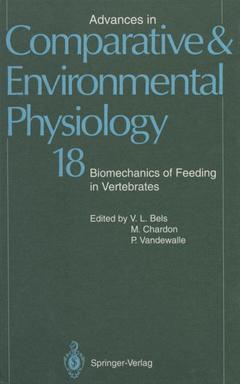Description
Biomechanics of Feeding in Vertebrates, Softcover reprint of the original 1st ed. 1994
Advances in Comparative and Environmental Physiology Series, Vol. 18
Coordinators: Bels V.L., Chardon M., Vandewalle P.
Language: English
Subject for Biomechanics of Feeding in Vertebrates:
Keywords
Anatomie, funktionelle, Anatomy, functional, Mammalia, Morphologie, adaptation, amphibians, anatomy, biomechanics, development, evolution, mammals, morphology, primates, system, vertebrates
Publication date: 11-2012
363 p. · 15.5x23.5 cm · Paperback
363 p. · 15.5x23.5 cm · Paperback
Description
/li>Contents
/li>
Although feeding is not yet been thoroughly studied in many vertebrates taxa, and different conceptual and methodological approaches of the concerned scientists make a synthesis difficult, the aim of the editors is to provide a comprehensive overview of the feeding design in aquatic and terrestrial vertebrates with a detailed description of its functional properties. The book emphasizes the constant interaction between function and form, behaviour and morphology in the course of evolution of the feeding apparatus and way of feeding both complementary and basically related to survival interspecific competition, adaptation to environmental changes and adaptive radiations. Special stress is drawn onquantification of the observational and experimental data on the morphology and biomechanics of the feeding design and its element jaws, teeth, hyoidean apparatus, tongue, in order to allow present and further comparisons in an evolutionary perspective.
1 Functional Properties of the Feeding Musculature.- 1 Introduction.- 2 Functional Properties of Individual Muscle Fibers.- 3 Fiber Types and Contractile Properties in Vertebrate Feeding Muscles.- References.- 2 Feeding Mechanisms in Sharks and Other Elasmobranchs T.H Frazzetta.- 1 Chondrichthyian Fishes.- 2 Elasmobranchs.- 3 The Shark Jaw Apparatus.- 4 Feeding behavior.- 5 Morphomechanics and function.- 6 Other Elasmobranchs.- 7 Conclusions.- References.- 3 The Pharyngeal Apparatus in Teleost Feeding.- 1 Introduction.- 2 Morphology.- 3 Role of the Pharyngeal Apparatus in Food Processing.- 4 Development of the Pharyngeal Jaws.- 5 Polymorphism and Plasticity of the Pharyngeal Jaw Apparatus.- 6 Concluding Remarks.- References.- 4 Feeding in Tetrapods.- 1 Introduction.- 2 Problems and Solutions for Terrestrial Feeding.- 3 Amphibians: Conflict and Prey Ingestion.- 4 Reptilian and Mammalian Prey Ingestion.- 5 Teeth, Crushing and Mastication.- 6 The Adductor Muscles and Their Action Patterns.- 7 Cycles.- 8 Overview.- References.- 5 Sensorimotor Processes That Underlie Feeding Behavior in Tetrapods.- 1 Behavior Patterns Related to Feeding.- 2 Definitions Referring to “Sensori-”, “Motor-”, and “Command-”.- 3 The Motor Part of Prey Snapping in Toads.- 4 The Feature-Analyzing Part of Prey Catching.- 5 A Concept of a Neuronal Circuit for the Tongue Flip.- References.- 6 Amphibian Feeding Behavior: Comparative Biomechanics and Evolution.- 1 Introduction.- 2 Overview of Feeding Mechanics in Fishes.- 3 Salamander Feeding Mechanics.- 4 Frog Feeding Mechanics.- 5 Comparative Analysis of Amphibian Feeding.- 6 Recommendations and Future Directions.- References.- 7 Biomechanics of the Hyolingual System in Squamata.- 1 Introduction.- 2 Functional and Biomechanical Studies of the Hyolingual System.- 3 Evolutionary Comparison of Hyolingual Biomechanics 234 References.- 8 Behavioral Mechanisms of Avian Feeding.- 1 Introduction.- 2 General Food Acquisition Mechanism: Pecking.- 3 Specific Food-Handling Mechanisms: Husking and Storage.- 4 Specific Food Acquisition Mechanisms.- 5 Sensory Control and Motor Patterning.- 6 Principles of Avian Food Acquisition.- References.- 9 Evolutionary Approach of Masticatory Motor Patterns in Mammals W.A Weijs.- 1 Introduction and Scope.- 2 The Evolutionary Development of the Mammalian Jaw Apparatus.- 3 Mammalian Jaw Muscles and Feeding Cycles: Definitions.- 4 Feeding in Primitive Mammals.- 5 Bats.- 6 Primates.- 7 Carnivores.- 8 Ungulate Grinding Type.- 9 Rodents.- 10 Discussion.- References.- 10 Differential Wear of Enamel: A Mechanism for Maintaining Sharp Cutting Edges A.W Crompton, C.B Wood and D.N Stern.- 1 Introduction.- 2 Material and Methods.- 3 Results.- 4 Discussion.- References.- Conclusion: A General Theory for Feeding Mechanics?.
© 2024 LAVOISIER S.A.S.




